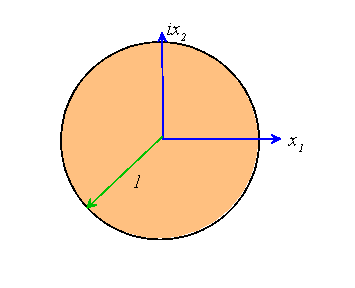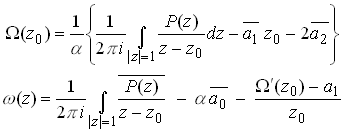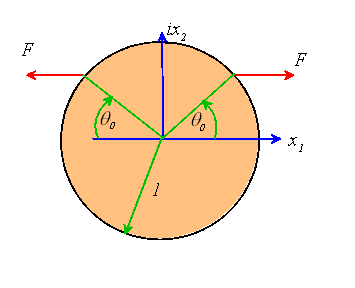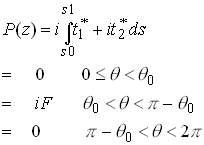 EN224: Linear Elasticity
EN224: Linear Elasticity 
Division of Engineering
7.5 Calculating Complex Potentials Using Cauchy Integral Formulae
There are some problems that are best solved by expanding the complex potentials as Taylor or Laurent series. This procedure works best if only a few terms in the series are needed. Otherwise, one often makes better progress by applying the Cauchy integral formulae. This procedure actually gives exact solutions for any displacement or traction boundary value problem, although the resulting integrals can be hard to evaluate unless the solid can be mapped conveniently to the unit circle.

We will illustrate the idea by using it to solve the problem of a circular disk subjected to arbitrary traction or displacement on its boundary.
We will assume that the disk has unit radius, without loss of generality.
Following the procedure outlined in Sections 7.1 and 7.2, then, our objective is to find complex potentials satisfying
With

Evidently

Where![]() is any point within the disk.
is any point within the disk.
Now, consider the three terms on the right hand side of this expression. Applying the Cauchy integral formula directly shows

To evaluate the second term, expand the complex potential as a Taylor series (we know this can be done, since the potentials must be analytic within the disk).

Now, since ![]() on |z|=1, we have
on |z|=1, we have

The first integral on the right hand side may be evaluated directly
using the Cauchy integral formula. The second term may be shown to be zero,
using residues, as follows. Recall that if a function f(z) has a
simple pole of order m at![]() , then
, then
where

Apply this to the particular case

This has a simple pole of order n at z=0 and a pole of
order 1 at ![]() , so
, so

wherupon

Thus

Next, consider

The complex potentials can only be determined to within an arbitrary
constant, even for a displacement boundary value problem – you can
clearly add a constant c to![]() and subtract
and subtract![]() from
from![]() and still generate the same displacement field. Thus, we may set
and still generate the same displacement field. Thus, we may set![]()
without loss of generality.
Let us collect the information that we’ve obtained so far. Substituting back for the three integrals we evaluated, we see that

We are close to finding a closed form expression for![]() , but we still
need to find some way to determine the constants
, but we still
need to find some way to determine the constants![]() . To do this,
expand
. To do this,
expand ![]() as a Taylor series
as a Taylor series

Differentiate this expression with respect to![]() , and set
, and set ![]() in
the result
in
the result

Similarly, differentiate with respect to![]() twice, and set
twice, and set![]()

For a displacement boundary value problem, the preceding two expressions
may be solved for![]() For the traction boundary value problem, one can only
determine
For the traction boundary value problem, one can only
determine![]() and the real part of
and the real part of![]() , because in this
case
, because in this
case![]() . This is to be expected, since we can only determine the
potentials to within an arbitrary rigid body motion. One may set the imaginary
part of
. This is to be expected, since we can only determine the
potentials to within an arbitrary rigid body motion. One may set the imaginary
part of![]() to zero in this case.
to zero in this case.
For future reference, we note that we can determine the first coefficient
in the Taylor series using the same idea. Simply set![]() :
:

We have now determined![]() . We still need to find
. We still need to find![]() , however. To
do this, rearrange the boundary conditions to
, however. To
do this, rearrange the boundary conditions to
We can use the Cauchy integral formula again to evaluate ![]() within the disk
within the disk

Since we’ve already determined ![]() this is good enough,
but it can actually be simplified: the second two integrals may be evaluated
by expanding
this is good enough,
but it can actually be simplified: the second two integrals may be evaluated
by expanding ![]() as a Taylor series, with the result
as a Taylor series, with the result

The details are left as an exercise.
Summary
The closed form solution to a displacement or traction boundary value problem for a disk of unit radius is

With



For traction boundary value problems, it is not necessary to evaluate![]() and
and![]()
Note that we can add any complex constant to both ![]() and
and![]() and still generate the same stress field, since only derivatives of potentials
appear in the expressions for stresses.
and still generate the same stress field, since only derivatives of potentials
appear in the expressions for stresses.
Therefore, we could add![]() to
to![]() and
and![]() to
to![]() without changing the stress field. If we do this, the expressions for the
potentials only involve P and
without changing the stress field. If we do this, the expressions for the
potentials only involve P and![]()
Example

We will use this procedure to determine the solution for a disk subjected to concentrated loads on its boundary, as shown below.
We begin by evaluating P. Recall that

Since this is a traction boundary value problem, we may set![]() as discussed earlier. Then,
as discussed earlier. Then,

Next,

Similarly

Amazing!
Clearly, the same idea can be used to solve problems involving a circular hole in an infinite solid, subjected to prescribed traction or displacement on its boundary.